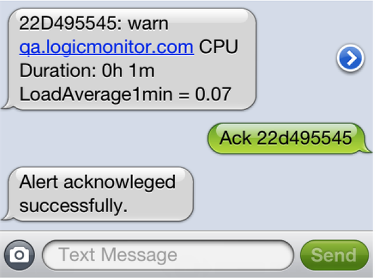Responding to native SMS alert notifications
Last updated - 23 July, 2025
When you receive alert notifications via native SMS, you can click the link in the SMS message to launch the LogicMonitor platform and respond to your alerts from a dedicated LogicMonitor page. Or, you can reply to the alert directly via SMS using the commands in the following table:
| Response Command | Description |
| ACK (required alertID) (optional comment) | Acknowledge the alert, with a comment if one is specified. The alert will be acknowledged, stopping any escalations. You will receive an SMS notification confirming the acknowledgement. Additionally, the ACK and comment will be emailed to any designated recipients for that Alert Chain. Please note, however, that any other SMS destination in the Alert Chain will not receive the acknowledgment notification. The alertID will be present in the alert notification, and is required in the response. For example, the response ACK LMD12345 comment would acknowledge alert LMD12345 |
| NEXT (required alertID) | Immediately escalate to the next stage in the escalation chain, without waiting for the escalation interval to pass. You can use this command if you get an alert, but are not in a situation to respond. The alertID will be present in the alert notification, and is required in the response. For example, the response NEXT LMD12345would escalate alert LMD12345 to the next escalation chain stage. |
| SDT (required alertID) X (optional comment) | Schedule downtime (SDT) for the instance in alert, for X hours. The value can be a decimal fraction to schedule SDT for less than an hour: e.g. SDT .25 = 15 minute SDT. The alertID will be present in the alert notification, and must be included in the response. For example, the response SDT LMD12345 12 would SDT alert LM12345 for 12 hours. The comment, if included, will be sent to others to whom the alert has already been escalated. |
| SDT host (required alertID) X (optional comment) | Schedule downtime for the specific device for X hours. The value X can be a decimal fraction to schedule SDT for less than an hour: e.g. SDT host .25 = 15 minute SDT. This will disable routing for all alerts triggered for the device until the SDT has expired. The alertID will be present in the alert notification, and must be included in the response. For example, the response SDT LMD12345 host 12 would SDT the device corresponding to alert LM12345 for 12 hours. |


